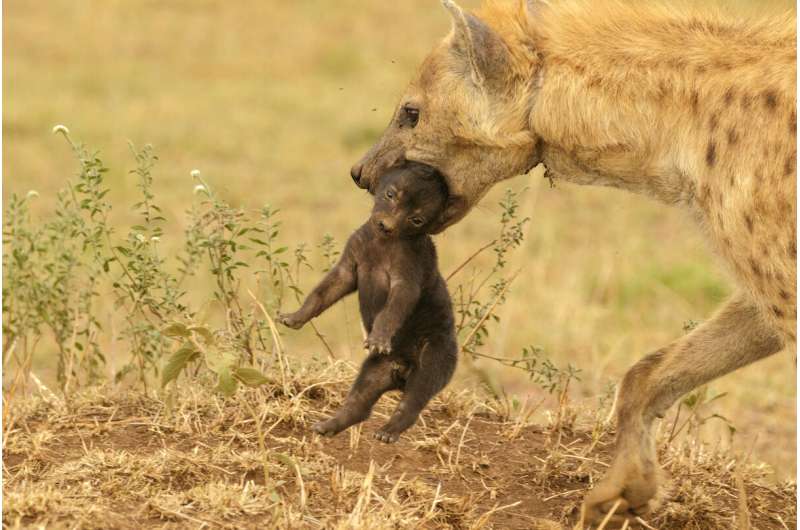Fewer and weaker offspring: Snare injuries decrease reproductive performance of female hyenas in the Serengeti

Indiscriminate snaring for bushmeat hunting may have varying collateral effects on non-target species, ranging from mild injuries to death. Beyond immediate mortalities these effects are rarely examined. A team of scientists from the Leibniz Institute for Zoo and Wildlife Research (Leibniz-IZW) now analyzed the life-history consequences of debilitating snare injuries in individually known female spotted hyenas between 1987 and 2020 in the Serengeti National Park, Tanzania. The long-term data revealed that injuries did not decrease the age expectancy of the hyenas, but hampered their reproductive performance. Debilitating injuries caused by snares delayed their age at first reproduction, decreased the size of their litters and reduced the survival of their offspring. These findings are published in the scientific journal Animal Conservation.
Although not directly targeted by bushmeat hunters, spotted hyenas (Crocuta crocuta) face a substantial risk of dying in a snare. In the center of the Serengeti National Park (NP), the annual risk was estimated at 8%. “This is because the main prey of spotted hyenas are migratory herbivores and hyenas throughout the park regularly travel long distances from their clan territories to forage in areas containing large aggregations of migratory herbivores before returning to their territory,” explain Dr. Marion L. East and Prof Heribert Hofer, senior authors of the study. Some hyenas manage to escape snares by gnawing through the snare’s tethering wire. Yet, even when death is not the immediate consequence, the injuries and their effects on the individual’s life may be severe. “Using long-term data from individually known female spotted hyenas we assessed the consequences of debilitating snare injuries on four components of their performance: longevity, age at first reproduction, litter size and offspring survival,” say first authors Dr. Sarah Benhaiem and Sara Kaidatzi from the Leibniz-IZW Department of Ecological Dynamics.
The scientists reported a total of 208 sublethal incidences of 193 hyenas with snares, snare-specific injuries or scars—mostly in the neck region—between 1987 and 2020 in the Serengeti NP. Incidences classified as debilitating injuries in female spotted hyenas from three closely monitored study clans were investigated in detail. “We found that females with these kinds of snare injuries did not differ from non-snared females in terms of longevity,” explains Benhaiem. “What we did find, on the other hand, is a clear negative effect of these injuries on female reproductive success,” adds Kaidatzi. A small number of female hyenas suffered from debilitating snare injuries before they had their first litter. They gave birth to their first litter at around 4.5 years, which is a delay of more than eight months compared to non-snared females (3.8 years). When looking at the effect of snares on the survival of offspring, the percentage of cubs surviving to one year of age was reduced. In the control group from the team’s long-term Serengeti data set, 51% of the cubs survived to one year, whereas only 42% of the cubs from females with debilitating snare injuries reached their first birthday. Last but not least, injured females did produce smaller litters than non-snared females: In the absence of being snared, 56% of the litters were twin litters, whereas among the snared females only 36% of the litters were twins.
“Our analysis shows that, even beyond immediate mortalities, indiscriminate snaring may have unintended yet profound effects on hyena populations as females who survive being caught in a wire snare with significant injuries have smaller litters which are less likely to survive,” Dr. East from the Leibniz-IZW summarizes. This long-term decrease in reproductive performance likely resulted from increased inflammatory and immune responses to the snare injury and/or a decreased ability to travel the long distances necessary to feed on migratory herbivores. “While our results are based on a relatively small sample of females with debilitating injuries, they suggest that the total population-level costs of wire snares in by-catch species may be underestimated and that future studies may want to account for the potential reproductive costs of sublethal snare injuries,” the authors conclude.
Spotted hyenas adjust their foraging behavior in response to climate change
S. Benhaiem et al, Long‐term reproductive costs of snare injuries in a keystone terrestrial by‐catch species, Animal Conservation (2022). DOI: 10.1111/acv.12798
Citation:
Fewer and weaker offspring: Snare injuries decrease reproductive performance of female hyenas in the Serengeti (2022, June 3)
retrieved 3 June 2022
from https://phys.org/news/2022-06-weaker-offspring-snare-injuries-decrease.html
This document is subject to copyright. Apart from any fair dealing for the purpose of private study or research, no
part may be reproduced without the written permission. The content is provided for information purposes only.
For all the latest Science News Click Here
For the latest news and updates, follow us on Google News.

